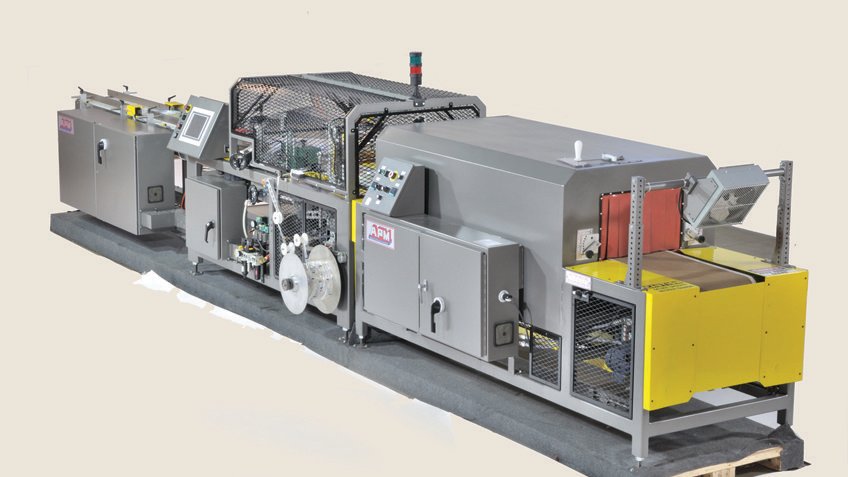Recommended For You
Whether it's plastic, paper or foam containers and lids – or single-use utensils – every foodservice provider uses disposable containers and cutlery.
And with the popularity of carryout and “meals on the go” on the upswing globally, the demand for disposable foodservice products is expected to rise at an annual rate of five percent or more. For the companies positioned to meet this need, time is money.
The more efficiently their equipment can convert material into consumer-ready product, the more profitable they will be. But to meet productivity goals, every speed improvement made at the front end of the conversion process must be matched by incremental gains on the packaging line.
DJS Systems, an innovative machine builder headquartered in Homer, Michigan, specializes in product handling and automation systems that improve end-of-line throughput for the thermoforming, paper converting and injection molding industries. Shortly after its founding in 2003, DJS Systems set about designing an efficient cup counter and vertical bagger system for the disposable foodservice market.
These systems count, stack and bag finished cups per end customer specifications, which dictate stack count and the number of stacks per bag. Ideally, counter/baggers run continuously and fast enough to keep up with the primary converting equipment upstream.
From the beginning, DJS Systems recognized that motor-driven control was the key to improving the speed, accuracy and flexibility of existing systems on the market. “Most systems used air-driven cylinders to control the motion applications,” explained Steve Sherman, vice president, DJS Systems. “Accuracy and speed can be difficult to maintain with pneumatic control because operation is affected by air quality, humidity and temperature.”
To improve repeatability, DJS Systems designed their first counter and vertical bagger using servo technology for motion control. Their initial system was built on a Rockwell Automation platform, featuring Allen-Bradley® MicroLogix™ controllers, AC drives and servo drives on a DeviceNet™ network. “The Rockwell Automation solution immediately differentiated our equipment,” said Mike Walper, sales manager, DJS Systems. “Integrated AC motor and servo control enabled us to run our system faster – and establish a recipe-driven interface to speed changeover.”
Working closely with Rockwell Automation Global OEM Technical Consultants (GOTCs) over a ten-year period, DJS Systems continuously improved their machine, ultimately increasing cycle time from 30 to 55 stacks per minute. “We felt we had maximized the performance of our
original equipment as much as we could,” Walper said. “Then our customers starting saying – if you can go faster, we can go faster. It was time for a major upgrade.” In designing the new equipment, DJS Systems took a hard look at current market trends and engaged the Rockwell Automation GOTC team.
The latest conversion machinery was able to churn out disposable containers faster than ever before. But just as critical, more end customers were specifying retail-sized packaging. For a counter/bagger at the end of the line, this means fewer products per stack – and faster cycle times. “Companies do not want to slow down their primary equipment,” Sherman said. “To accommodate the shorter stacks and faster cycle times, many companies divert the counter/bagger operation to multiple machines or take it offline. We wanted to provide a better way.”
The company's new integrated servo counter and vertical bagger system is designed for continuous, inline operation and features a Rockwell Automation control solution based on the Allen-Bradley CompactLogix™ programmable automation controller. For motion control, the 5-axis system uses Allen-Bradley Kinetix® 300 and Kinetix 350 servo drives. Allen-Bradley PowerFlex® 525 AC drives control the infeed and discharge conveyors.
The system is integrated on an EtherNet/IP™ network and incorporates Stratix 5700™ managed industrial Ethernet switches.
“Without changing the mechanics of the equipment, the new control system enabled us to improve speed by about 20 percent,” Walper said. “We now have a fully scalable platform that can be used on the smallest to the largest system. This allows us to customize the solution to each customer's requirements.”
The system can achieve up to 70 cycles per minute. Through the recipe-driven interface, it can be quickly configured to change stack count – and to modify the number of stacks per bag from 1 to 8. In addition, thanks to EtherNet/IP connectivity, DJS Systems can now off er remote equipment monitoring. “EtherNet/IP is the preferred protocol for most of our customers,” Walper said. “Now, we can easily help program and troubleshoot installed systems from our Michigan headquarters. This is becoming increasingly important as our customer base expands globally.” “Throughout system development, Rockwell Automation helped ensure our equipment was fully tested and validated,” Sherman added. “As a company, our objective is to deliver machinery that keeps pace with primary conversion equipment. Rockwell Automation helped us meet our goals.”
Published March 1, 2015

